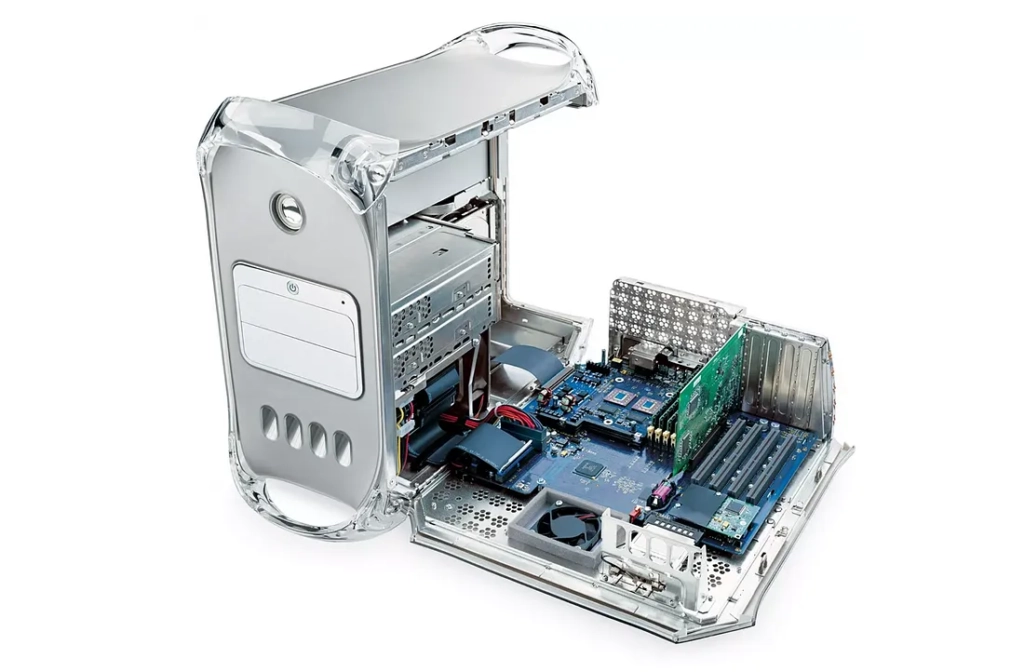On January 28th, 2003, Apple revolutionized the computing world with the introduction of the Power Mac G4 Early 2003 (Mirrored Drive Doors). As part of the esteemed Power Mac G4 series, this sleek and powerful computer marked a significant milestone in Apple’s history, offering users unparalleled performance and style.
Apple’s announcement heralded the arrival of the fastest and most affordable Power Mac G4 line ever seen. With a choice of single 1 GHz, dual 1.25 GHz, or dual 1.42 GHz PowerPC G4 processors, users could tailor their computing experience to suit their needs, with prices ranging from $1,499 to $2,699. This new line also boasted cutting-edge features such as FireWire 800 and internal support for 54Mbps AirPort Extreme and Bluetooth wireless networking.
Built on Apple’s advanced Xserve architecture, the Power Mac G4 Early 2003 boasted up to 2 MB of fast Double Data Rate (DDR) Level 3 cache and 333 MHz DDR memory. This powerhouse harnessed the power of Apple’s UNIX-based Mac OS X Jaguar, offering symmetric multiprocessing capabilities and delivering an astonishing 21 gigaflops of performance.
The Power Mac G4 provided unparalleled expansion capabilities, boasting five slots, including four open high-performance 64-bit 33 MHz PCI slots and two external drive bays for optical drives. With options like Apple’s SuperDrive (DVD-R/CD-RW) and the new faster Combo (DVD-ROM/CD-RW) optical drive, users could enjoy enhanced performance and versatility for their computing needs.

Equipped with a range of connectivity options, the Power Mac G4 Early 2003 ensured users stayed connected in the digital age. With a new high-speed FireWire 800 port, two FireWire 400 ports, and four USB 1.1 ports, alongside support for high-speed 54Mbps AirPort Extreme 802.11g wireless networking and optional built-in Bluetooth, users could seamlessly integrate their devices for a streamlined computing experience.
Every Power Mac G4 came bundled with Apple’s iLife applications, including iTunes 3, iPhoto 2, iMovie 3, and iDVD 3, offering users a comprehensive suite of tools for managing digital media and creative projects. Additionally, a bundle of professional and productivity applications, including QuickBooks for Mac New User Edition and Microsoft Office v. X Test Drive, provided added value for users seeking to enhance their productivity.
Upon its launch, the Power Mac G4 Early 2003 was priced at $1,499, offering consumers advanced technology at a reasonable cost. Available through the Apple Store, Apple Retail Stores, and Apple Authorized Resellers, users had access to a range of configurations and options to customize their computing experience.
Although the Power Mac G4 Early 2003 had a brief existence, discontinued on June 23, 2003, it remains a nostalgic piece of Apple’s history and a testament to the company’s commitment to innovation. Today, 21 years later, its memory lives on as a reminder of Apple’s past and its enduring legacy of technological advancement.
Whether you’re a nostalgic tech enthusiast or simply appreciate Apple’s contributions to the computing world, the Power Mac G4 Early 2003 holds a special place in the hearts of many. With its groundbreaking features, unmatched performance, and timeless design, it stands as a symbol of Apple’s innovation and vision for the future of computing.

Power Mac G4 Early 2003 Details
| Introduced | January 28, 2003 |
| Discontinued | June 23, 2003 |
| Model Identifier | PowerMac3,6 |
| Model Number | M8570 |
| EMC | 1914 |
| Order Number | M8839LL/A (1 GHz) M8840LL/A (dual 1.25 GHz) M8841LL/A (dual 1.42 GHz) |
| Original Price | $1,499 $1,999 $2,699 |
| Colors | QuickSilver |
| Weight | 42 Ibs. 19.050 KG |
| Dimensions | 17” H x 8.9” W x 18.4” D 43.18 cm H x 22.6 cm W x 46.73 cm D |
Power Mac G4 Tech Specs
Processor
| Processor | PowerPC 7455 G4 |
| Processor Speed | 1 GHz Dual 1.25 GHz Dual 1.42 GHz |
| Architecture | 32-bit |
| Number of Cores | 1 or 2 |
| System Bus | 133 MHz (1 GHz) 167 MHz (Dual 1.25 GHz 1.42 GHz) |
| Cache | 64 KB L1 256 KB L2 2 MB L3 |
Storage & Media
| Storage | 60 GB 7200 rpm 80 GB 7200 rpm 120 GB 7200 rpm |
| Media | 1 – 12x DVD-ROM/CD-RW “Combo” drive or 4x DVD-R/CD-RW “SuperDrive” |
Memory
| Built-in Memory | 256 MB 512MB |
| Maximum Memory | 2 GB |
| Memory Slots | 4 – PC-2100 184-pin DDR SDRAM (1 GHz) 4 – PC2700 184-pin DDR SDRAM (Dual 1.25 GHz and 1.42 GHz) |
| Interleaving Support | No |
Display
| Built-in Display | None |
Graphics
| Graphics Card | NVIDIA GeForce4 MX NVIDIA GeForce4 Ti ATI Radeon 9000 Pro ATI Radeon 9700 Pro |
| Graphics Memory | 32 MB (GeForce4 MX) 64 MB (Radeon 9000 Pro) 128 MB (GeForce4 Ti or Radeon 9700 Pro) |
| Display Connection | 1 – ADC 1 – DVI |
| Display Modes | Dual display extended and video mirroring |
Expansion
| Expansion Slots | 4 – 33 MHz 64-bit PCI 1 – 4x AGP |
| Bays | 4 – Internal 3.5″ ATA drive bays 2 – Optical drive bay |
| Hard Drive Interface | 1 – Ultra ATA/66 (ATA-5) 1 – ATA/100 (ATA-6) |
| Optical Drive Interface | EIDE (ATA-3) |
Connections
| Ethernet | 10/100/1000BASE-T (RJ-45) |
| Modem | 56k |
| Wi-Fi | AirPort Extreme Card 802.11b/g (Optional) |
| Bluetooth | Bluetooth 1.1 (Optional) |
| ADB | None |
| USB | 2 – 12 Mbps |
| Serial | None |
| SCSI | None |
| FireWire | 2 – 400 Mbps 1 – 800 Mbps |
| Audio In | 1 – 3.5-mm analog input jack |
| Audio Out | 1 – 2.5-mm Apple Pro Speaker minijack 2 – 3.5-mm analog output jack 1 – Built-in speaker |
| Display | 1 – DVI 1 – ADC |
Keyboard and Mouse
| Peripherals | Apple Pro Keyboard Apple Pro Mouse |
Software
| Original OS | Mac OS X 10.2.3 |
| Later OS | Mac OS X 10.2.4 Mac OS X 10.2.6 |
| Maximum OS | Mac OS X 10.5.8 |
| Firmware | Mac OS ROM |
| Bundled Software | Mac OS X 10.2 QuickTime iCal iChat iLife (includes iTunes, iPhoto, iMovie, and iDVD) DVD Player iSync Mac OS X Mail Microsoft Internet Explorer EarthLink Acrobat Reader Art Directors Toolkit FAXstf FileMaker Pro Trial GraphicConverter Microsoft Office OmniGraffle OmniOutliner QuickBooks for Mac New User Edition Developer Tools |
Power
| Backup Battery | 3.6 V 850 mAh Lithium (922-4028) |
| Maximum Continuous Power | 360 W |
| Line Voltage | 100 – 125 V AC or 200 – 240 V AC |
Further Reading and References
- Power Mac G4 (FW800): Technical Specifications – Apple Support
- Apple Unveils Fastest and Most Affordable Power Macs Ever – Apple Newsroom
- Power Mac G4 – Wikipedia
- Power Mac G4 (Mid 2003) – Low End Mac
- Power Macintosh G4 (FireWire 800) – Apple History
- The Power Mac G4 Line – MacStories
- The Lazarus Mac: Power Macintosh G4 (Mirrored Drive Doors 2003) – 512 Pixels
Disclaimer: The data presented in this article is under continuous development and has been manually collected from various sources based on their availability. The author of this article may revise this dataset as additional research is conducted and reviewed. Please note that the information is provided “as is” and “as available” without express or implied warranties. The author cannot be held responsible for any omissions, inaccuracies, or errors in the published information. Any warranties relating to this information are hereby disclaimed.
Last updated: February 14, 2024
